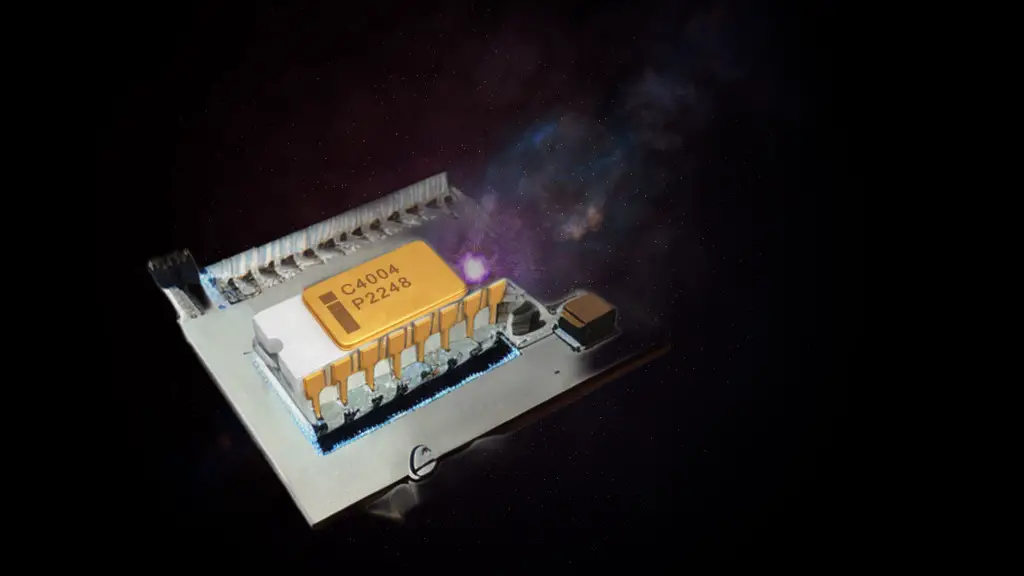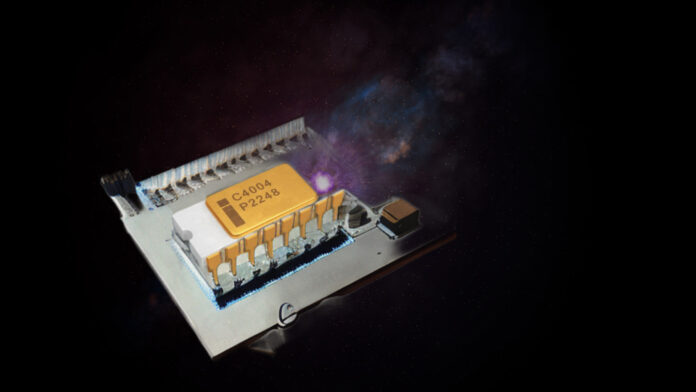Back in 1971, a small but mighty chip made its debut in the world of computing, forever changing the course of technology. The Intel 4004, the first commercially produced microprocessor, packed an astonishing amount of power into its tiny frame. With its innovative design and groundbreaking use of MOS silicon gate technology, this humble 4-bit CPU became the catalyst for a new era of computing. Let’s take a closer look at how the Intel 4004 transformed the landscape of digital innovation.
Unleashing the Power of Integration: The Intel 4004’s claim to fame lay in its ability to achieve large-scale integration, a feat that seemed almost impossible at the time. By leveraging the MOS silicon gate technology, Intel managed to fit twice as many transistors onto a single chip compared to previous technologies. This breakthrough not only resulted in a more compact design but also unleashed a remarkable five-fold increase in operating speed. The integration of complex logic and memory circuits on a single chip became a reality, effectively replacing multi-chip CPUs of the past.
A Collaborative Journey: The story of the Intel 4004 is one of collaboration and visionary minds. The brainchild of Federico Faggin, who had previously worked on the development of the MOS silicon gate technology, the 4004 owed its success to the contributions of talented engineers like Masatoshi Shima. Together, they navigated the challenges of design complexity and sought to create a more efficient and versatile CPU architecture. Their dedication paid off when the first fully operational 4004 was delivered to Busicom Corp., marking a pivotal moment in computing history.
Innovations that Transformed Computing: The Intel 4004 boasted several groundbreaking innovations that made its single-chip marvel possible. Faggin’s ingenious use of self-aligned gates, constructed from polysilicon instead of metal, enabled components to be densely packed and operate at higher speeds. The “bootstrap load” and “buried contact” techniques further elevated the chip’s efficiency, enabling direct connections between silicon gates and transistors. These innovations not only doubled the circuit density but also reduced costs significantly, paving the way for the 4004’s remarkable capabilities.
The Legacy Continues: Following its debut, the Intel 4004 continued to evolve. Faggin further refined the design, resulting in the Intel 4040 in 1974. While subsequent Intel processors like the 8008 and 8080 may share similar names, they were unrelated to the 4004’s architecture. Nonetheless, the impact of the 4004 on the world of computing cannot be overstated. Its pioneering advancements set the stage for the microprocessors we rely on today, fueling the relentless pursuit of smaller, faster, and more powerful technologies.
History
The world of computers and technology has witnessed remarkable advancements over the years. One crucial milestone in this journey was the introduction of the Intel 4004, a groundbreaking microprocessor that revolutionized the way we think about computing. Developed by Intel Corporation, the 4004 marked the beginning of a new era, laying the foundation for modern-day processors. Let’s take a closer look at the systematic history of the Intel 4004 in a simple and easy-to-understand language.
Birth of a Game-Changer: In the early 1970s, computers were massive machines that occupied entire rooms. They were expensive, difficult to maintain, and required highly skilled individuals to operate them. Intel, a young and ambitious company at the time, set out to change this landscape. Their goal was to create a compact, affordable, and versatile computer chip that could perform multiple tasks, paving the way for personal computing.
Enter the Intel 4004: In 1971, Intel unveiled the Intel 4004 microprocessor, a tiny piece of silicon that would reshape the future of computing. This revolutionary chip, measuring only 12 by 15 millimeters, contained an impressive 2,300 transistors. To put this into perspective, a single transistor is like a tiny electronic switch that can either be turned on or off, and it is the fundamental building block of modern electronics.
Unleashing New Possibilities: The Intel 4004 was designed to handle calculations and perform tasks that were previously only possible with larger computer systems. It boasted a clock speed of 740 kHz, allowing it to execute up to 92,000 instructions per second. This breakthrough in speed and performance opened the door to a wide range of applications, from calculators and cash registers to industrial control systems.
Collaboration and Innovation: The development of the Intel 4004 was a collaborative effort. A team led by Federico Faggin, Masatoshi Shima, and Ted Hoff worked tirelessly to design and refine the microprocessor. Their innovation was not limited to the chip itself but also included the creation of a new programming language, assembly code, specifically tailored for the 4004. This simplified the process of writing software for the microprocessor, making it more accessible to programmers and engineers.
Legacy and Impact: The Intel 4004’s impact on the computing industry cannot be overstated. It set the stage for rapid advancements in microprocessor technology, leading to the development of increasingly powerful and versatile chips. The principles and concepts established by the 4004 paved the way for the personal computer revolution, enabling the creation of smaller, faster, and more affordable machines that we rely on today.
Design and Description
The Intel 4004 microprocessor marked a significant technological breakthrough during its time. It employed an advanced 10 μm process silicon-gate enhancement-load pMOS technology, fitting impressive capabilities onto a compact 12 mm2 die. With a remarkable execution rate of approximately 92,000 instructions per second and a swift 10.8-microsecond instruction cycle, the 4004 aimed to match the clock rate of the IBM 1620 Model I.
The manufacturing process of the 4004 involved a meticulous procedure, with patterns physically cut at 500x magnification on a large Rubylith sheet. While this method has been rendered obsolete by modern computer graphic design capabilities, it played a crucial role in producing the microprocessor.
To assess the quality of the chips, a dedicated tester was developed by Federico Faggin, specifically designed for the silicon wafers of the MCS-4 family. Notably, this tester was powered by the 4004 chip itself, serving as both a testing instrument and a compelling demonstration of the management of the 4004’s suitability for control applications beyond calculators.
The 4004 boasted unique functionalities, including direct low-level control of memory-chip selection and I/O operations, which are not typically handled by microprocessors. However, it had limitations such as the inability to execute code from RAM and reliance on instructions provided in ROM or an independently loaded RAM acting as ROM. Additionally, the integration of I/O functions into the RAM and ROM chips reduced the overall part count in MCS-4 systems. This required the inclusion of processor-like logic on the memory chips to process relatively high-level data-transfer instructions.
A typical 4004 system configuration comprised up to 16 × 4001 ROM chips and 16 × 4002 RAM chips. This arrangement provided 4 KB of program storage, 1024 + 256 nibbles of data/status storage, as well as 64 input/output external data/control lines for comprehensive connectivity. Intel’s documentation suggested that by utilizing simple gating hardware, it was possible to connect up to 48 ROM and RAM chips, allowing for a maximum of 192 external control lines. However, specific implementation details or examples were not provided in the documentation.
Technical Specifications
The Intel 4004, introduced in 1971, operated at a maximum clock rate of 740 kHz, which allowed it to perform a substantial number of operations per second. Each instruction cycle took a minimum of 10.8 microseconds, divided into eight smaller clock cycles. The execution time for instructions varied, ranging from one to two machine cycles, corresponding to 10.8 or 21.6 microseconds. This meant the processor could handle approximately 46,250 to 92,500 instructions per second.
- Initial clock speed: 108 kHz
- Transistors: 2,300
- Manufacturing technology: 10 microns.
Notably, the Intel 4004 exhibited its computational prowess when tasked with adding two 8-digit decimal numbers, with each digit represented by 4 bits in Binary Coded Decimal (BCD) format. This operation, taking approximately 850 microseconds or 79 machine cycles (632 clock ticks), required an average of around 10 cycles (80 ticks) per digit pair. In practical terms, the processor could perform roughly 1,176 additions of 8-digit numbers per second.
The architecture of the Intel 4004 featured separate storage for program instructions and data, albeit using a single multiplexed 4-bit bus to transfer different types of information. This shared bus facilitated the transfer of 12-bit addresses, 8-bit instructions, and 4-bit data words. In terms of memory, the processor could directly access 5,120 bits of Random Access Memory (RAM), equivalent to 640 bytes. The RAM was divided into 1,280 4-bit “characters,” with 1,024 characters designated for data and 256 characters for status information. Additionally, the processor had direct access to 32,768 bits of Read-Only Memory (ROM), organized into 4,096 8-bit words (bytes).
The instruction set of the Intel 4004 comprised 46 instructions, consisting of 41 instructions that were 8 bits wide and 5 instructions that were 16 bits wide. The processor boasted a register set consisting of 16 registers, each capable of storing 4 bits of information. Moreover, it incorporated an internal subroutine stack capable of accommodating up to three levels of subroutines, enhancing its ability to execute complex tasks and manage program flow effectively.
Also Read: Unveiling the Intel 8008: Pioneering the Era of Microprocessors
Also Read: Timeline and Generations of Intel Processors | Advancement of Intel Processors
Frequently Asked Questions
When was the Intel 4004 microprocessor introduced?
The Intel 4004 was introduced in 1971.
How many transistors were there in the Intel 4004?
The Intel 4004 contained 2,300 transistors.
What was the clock speed of the Intel 4004?
The Intel 4004 operated at a maximum clock speed of 740 kHz.
How fast was the Intel 4004 in terms of instructions per second?
The Intel 4004 could execute approximately 46,250 to 92,500 instructions per second, depending on the instruction being executed.
What were the primary applications of the Intel 4004?
The Intel 4004 was used in applications such as calculators, cash registers, and industrial control systems.
Who were the key contributors to the development of the Intel 4004?
Federico Faggin, Masatoshi Shima, and Ted Hoff were among the key contributors to the development of the Intel 4004.
How did the Intel 4004 impact the computing industry?
The Intel 4004 set the stage for rapid advancements in microprocessor technology, leading to the development of smaller, faster, and more affordable processors. It played a crucial role in the personal computer revolution.
What were the limitations of the Intel 4004?
The Intel 4004 had limitations such as the inability to execute code directly from RAM and the reliance on instructions provided in ROM or loaded RAM acting as ROM.
How much memory could the Intel 4004 directly access?
The Intel 4004 could directly access 640 bytes of Random Access Memory (RAM) and 4,096 bytes of Read-Only Memory (ROM).
Did the Intel 4004 have an instruction set?
Yes, the Intel 4004 had an instruction set consisting of 46 instructions, including both 8-bit and 16-bit instructions.
What were the dimensions of the Intel 4004 chip?
The Intel 4004 chip measured approximately 12 by 15 millimeters.
Did the Intel 4004 have any successors?
The Intel 4004 was succeeded by the Intel 4040, which was a refined version of the original microprocessor.
How did the Intel 4004 contribute to the development of personal computing?
The Intel 4004 paved the way for smaller, faster, and more affordable processors, which played a crucial role in the development of personal computers. It enabled the creation of versatile machines that could handle various tasks.
-
The Intel 4004: A Revolutionary Microprocessor That Shaped Computing History

Back in 1971, a small but mighty chip made its debut in the world of computing, forever changing the course of technology. The Intel 4004, the first commercially produced microprocessor, packed an astonishing amount of power into its tiny frame. With its innovative design and groundbreaking use of MOS silicon gate technology, this humble 4-bit…


